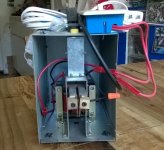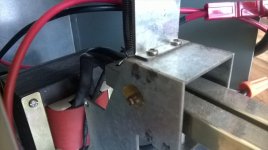burningwings
100 mW
- Joined
- May 3, 2015
- Messages
- 37
Does anybody have experience with the 788 spot welder sold on Alibaba ?
burningwings said:Has anyone used the 788 spot welder on 18650 cell connections ? I want to build a 18650 battery .
Syonyk said:I've just finished some teardown pictures from a repair of one - the triac blew up (110v version).
silentflight said:Lots of good info on your blog- welcome to Endless Sphere!
What is the current limit on the circuit breaker you are running the 788+ on? I read it would need more than 20 amps when used on a 110 volt line.
Syonyk said:If I continue having problems, I'm considering getting a 220v unit and a step up transformer, though before that, I'll probably just pair up two triacs to spread the load around. They're theoretically 30A triacs, with a 20A fuse, on a 15A circuit... so I'm hoping I just had a bad one from the factory, though if you look at the cooling (or lack thereof), I can entirely understand why they'd get hot in that location. A fan in the rear of the unit is probably sufficient to keep things cool, as long as I take it easy on the welding duty cycle.
Now I can get back to my actual goal of rebuilding an iZip Ultra pack...
riba2233 said:Adding step up transformer will only ease things on welder, but not on your power grid and installations. It would also require very large, bulky and expensive transformer.
I doubt you had one bad from the factory, it's just poor design, I've seen few of them with blown triacs. I don't know how they act in parallel.
While shopping for a spot welder I was in communication with an alibaba seller of the 788+. I asked about the 110v units, and he replied that some people had upgraded their circuit breakers to 40 amps. I wondered whether some sellers had just replaced the cords and not altered the winds on the transformers or some such. Rather sketchy information source, but there you have it.Syonyk said:Where on earth did you find any documentation on this?
silentflight said:On the other hand, no one in the US is manufacturing inexpensive, reliable spot welders for hobbyists- so good on you, China!
Yes, but it isn't a fair competition. Being inspired by the beauty of the Adriatic coast as well as the beauty walking the streets, the Croatian is at an advantage.riba2233 said:But there are in Croatia
riba2233 said:Yeah, good points, maybe it would be best to check it out with scope.
Can you check the temperature during operation? I ask because I'm not sure whether fan would help, since load is in ms, so the duty is pretty low.
silentflight said:I like your quote "That's probably fine..." I've spent a few months in China, and that would be the optimal three word summary of my overall experience.
On the other hand, no one in the US is manufacturing inexpensive, reliable spot welders for hobbyists- so good on you, China!
I hope you will post photos of your pack build in a thread or a link to your blog.
riba2233 said:But there are in Croatia :lol:
silentflight said:I've found a local source for quality spot welding, but I eventually want a welder for myself. A combination of an A123 battery with a boosting capacitor and the JP welder seems like a good solution to me. It just feels right to use A123 cells with a mind-blowing C rate for a welder and to strap an XL capacitor across the leads has a DocBass scifi feel to it, while completing it with a lightweight, compact unit built by a Croatian with better English than my own- seems like a 2015 solution.
Syonyk said:The triac is opening and closing 4 times per weld, though (with dual pulse welding).
Well, you've got that whole Eastern European thing going out there, where "If you want it done, find a way to do it yourself" is much more common (and lawsuits are, per my understanding, significantly less common).
Despite the fact that "Short a lead acid starter battery across your workpiece with a few MOSFETS" (yes, I've seen your welder, and I think it's great!) is a viable way to spot weld things, that would not last long as a product in the USA. We still have plenty of people who think ebikes are cheating (because bicycling is a Proper Recreational Sport, not a way of commuting).
silentflight said:Yes, but it isn't a fair competition. Being inspired by the beauty of the Adriatic coast as well as the beauty walking the streets, the Croatian is at an advantage.
I've found a local source for quality spot welding, but I eventually want a welder for myself. A combination of an A123 battery with a boosting capacitor and the JP welder seems like a good solution. It just seems right to use A123 cells with a mind-blowing C rate for a welder. Strapping an XL capacitor across the leads has a DocBass scifi feel to it, while completing it with a lightweight, compact unit built by a Croatian with better English than my own- seems like a 2015 solution.



Syonyk said:I've just finished some teardown pictures from a repair of one - the triac blew up (110v version).
Welder details:
http://syonyk.blogspot.com/2015/05/overview-of-sunkko-788-welder.html
Repair and re-engineering details:
http://syonyk.blogspot.com/2015/05/sunkko-788-welder-failure-and-repair.html
mcintyretj said:Burningwings, $136.16 is a good price for a spot welder
mcintyretj said:Syonyk, Not sure what a traic is, but, I probably had a similar problem with my 787a spot welder
I have the earlier version of this welder, the 787, and it looks almost the same as the 788. I used it for a 4p 15s 18650 build and it worked fine. I could not get good consistent welds on the thicker nickle tabs but it worked great on the supplied thinner tabs. When I started work on a 12p 15s battery I was doing about 20-30 welds in under 2 minutes which, I believe, is more that these units can handle. The welder stopped working. I decided to scrap all the electronics and just use a switch as shown in hundreds of youtube videos. Here is the welder today.
I just use a house light switch and a quick on-off flick of the thumb to get a solid weld. The problem I have is the black leads from the transformer to the copper leads get really hot after about 15 welds. On my battery you can see burn marks on many welds because I was in a hurry (copper sticking to nickle tabs). I needed to take a break for a few minutes and cool with a house fan before starting up again. Here is a close-up.
I also replaced the fuse with a 20 amp curcuit breaker.
With no face on the welder you have about 4 inches of reach for welding so I did not have to construct extensions.
Hope this helps.
Good luck!
Nobuo said:This is really valuable info, If I get your permission Syonyk, will link this in the "18650 spot welding -how to- ULTIMATE REPOSITORY" attached to the same welder linked in the spot welders section.
Thank you very much for sharing
